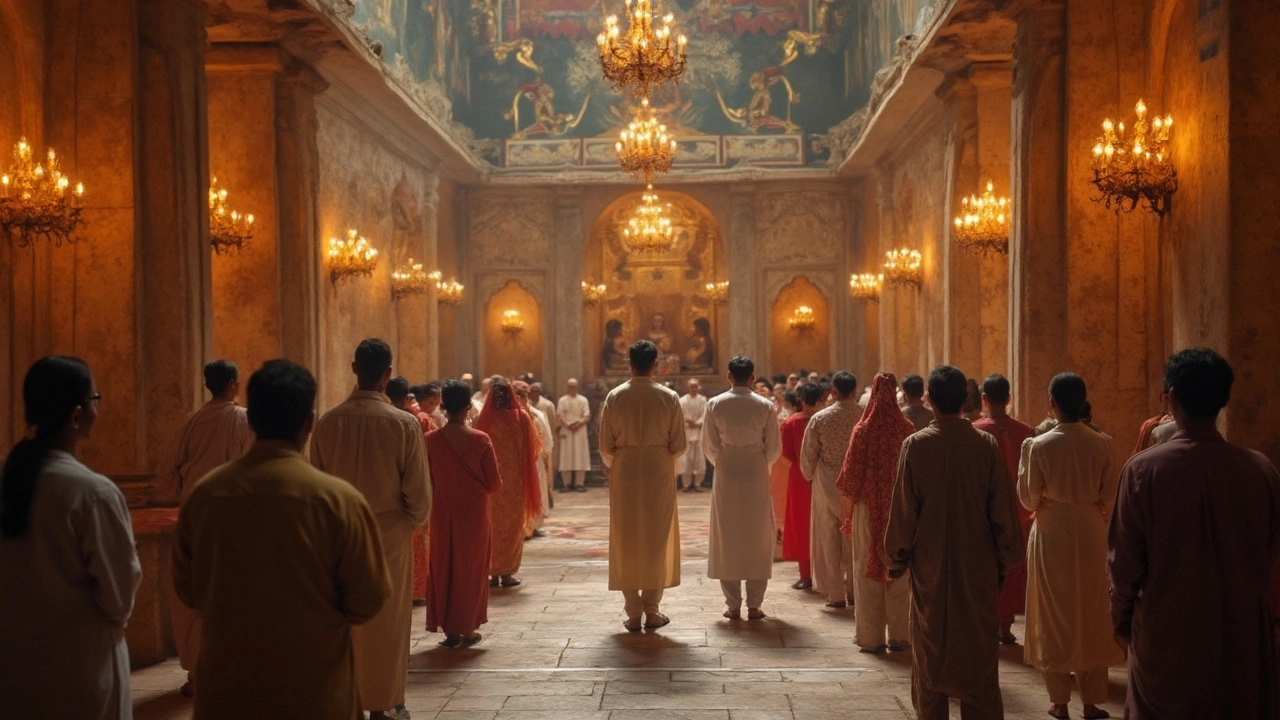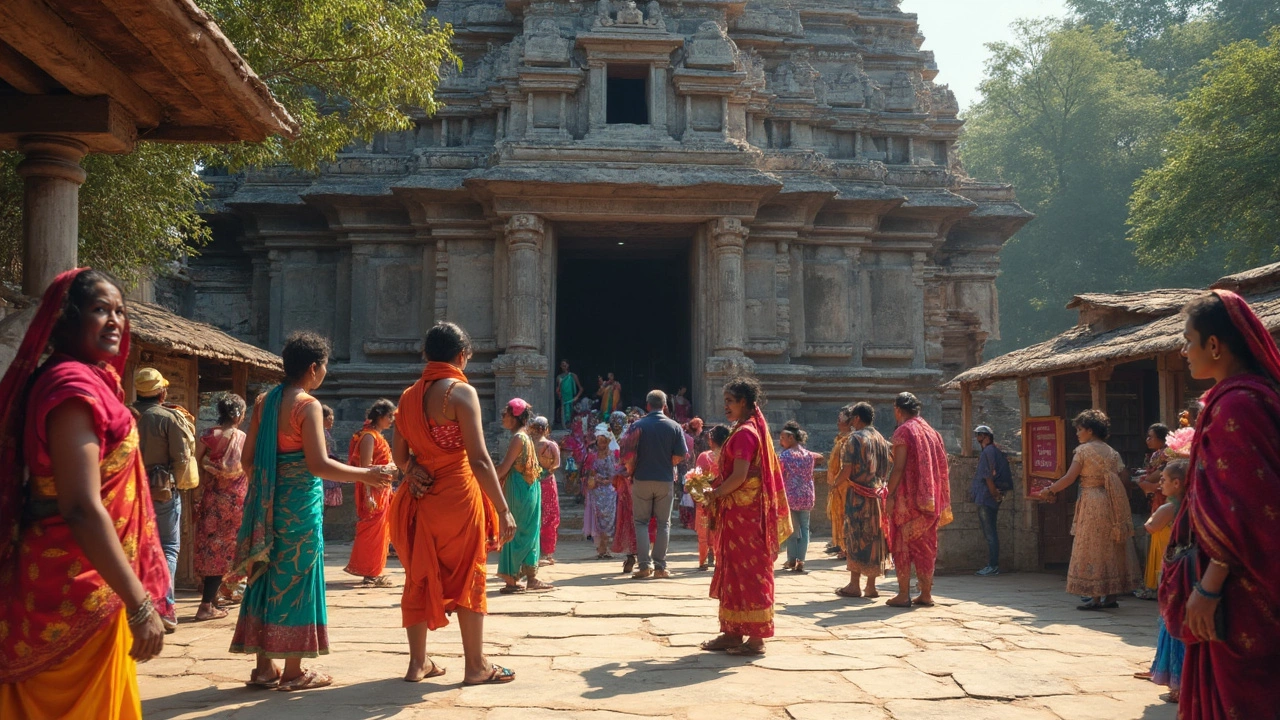Show up at an Indian temple in shorts or a sleeveless top, and you’ll stick out like a sore thumb. Most temples have strict dress codes, especially in South India, where men sometimes need to remove shirts and women are expected to cover arms and legs. It’s not just about blending in—it’s about respect. Forgot a shawl? Many temples rent or lend them, but planning ahead saves you the last-minute scramble.
You won’t find signs saying “No loud talking” everywhere, but you’ll feel the glares if you turn your temple trip into a group chat. These spaces are meant for quiet reflection. Think of it as being in a library—minus the books, plus a lot more incense. Want to click photos everywhere? Hold up. Most temples ban inner sanctum photography, and some even outside shots. Check first; your Instagram post isn’t worth disrespecting devotees or temple priests.
- Forget the Dress Code? Big Mistake
- Noisy, Pushy, or Rushed? Not Cool
- Photography Fails and Social Media Slip-Ups
- Food, Feet & Hands: What Not to Bring or Do
- Respecting Rituals: Don’t Be That Tourist
Forget the Dress Code? Big Mistake
Skipping the dress code at Indian temples is one of the fastest ways to get side-eyed—or even denied entry. Across India, from the towering Meenakshi Temple in Madurai to the famous Jagannath Temple in Odisha, following dress rules isn’t optional. It’s a big part of showing respect, whether you’re a tourist or a regular worshipper.
Most temples want visitors to cover shoulders, arms, and legs. That means no shorts, no sleeveless tops, and definitely no crop tops. Some southern temples, like Guruvayur in Kerala, even ask men to remove shirts and wear a simple cotton wrap called a dhoti. Women are expected to wear sarees or long dresses and cover their hair with a scarf in more traditional areas.
Got caught without the right clothes? It's awkward, but some big temples offer spare wraps, shawls, or even sarongs at the entrance. The Tirupati temple in Andhra Pradesh handles around 50,000 visitors every day and provides rental options, so you don't have to turn back at the door.
Here's a quick cheat sheet for staying on the safe side when visiting temples on your temple tours India adventure:
- Bring a light scarf or shawl that can double as a cover-up.
- Wear clothes that cover most of your arms and legs. Loose cotton pants and simple tops work well.
- Leave your flashy or tight outfits for another day.
- Check temple websites or signs for their rules—some are stricter than others.
Here’s a look at dress code rules in some of the most popular temples:
| Temple | Location | Men | Women |
|---|---|---|---|
| Guruvayur Temple | Kerala | Dhoti; shirts not allowed | Saree, salwar kameez, or long skirt & top |
| Meenakshi Temple | Tamil Nadu | Shirt and full-length pants/dhoti | Dress covering legs and shoulders |
| Tirupati Balaji | Andhra Pradesh | Dhoti and shirt or kurta | Saree, salwar kameez, or churidar with dupatta |
If you’re ever unsure, ask a local or just look around—nobody will mind if you’re cautious, but you’ll definitely stand out if you get it wrong. Respect the tradition, and it’ll make your visit way smoother—and way less embarrassing.
Noisy, Pushy, or Rushed? Not Cool
If you walk into an Indian temple expecting a fast-paced tourist attraction, pump the brakes. These places aren’t about moving quickly or squeezing past people for a better view. Patience is the rule—whether you’re waiting in line for darshan (seeing the deity) or just soaking up the vibe.
Loud talking is a big no-go. Temples in India are set up for worship, so most people slip into a more hushed, focused mood the moment they step inside. If you start chatting loudly or crack a joke, you’ll notice people turning to look. Some old temples, like those in Varanasi or Tamil Nadu, even have guards who will tell you to lower your voice if you get too chatty.
Pushing or cutting in line is another classic mistake tourists make, especially at bigger temples like Tirupati or Shirdi, where crowds can number in the thousands. People wait for hours, and jumping ahead will definitely get you called out—sometimes politely, sometimes not. Respect the order, no matter how long it takes.
- Keep your phone on silent. Even a simple ringtone can feel jarring in the middle of prayers.
- If you’re in a group, whisper instead of talking out loud.
- Follow the line, and don’t shove when things get crowded.
- If you have kids, remind them that running or shouting inside isn’t okay.
Some temple tours India guides will prep travelers on basic etiquette, but not everyone does. So always watch what the locals do and match their energy. If you rush or act impatient, you’re not just being rude—you’re missing the point of the visit in the first place.

Photography Fails and Social Media Slip-Ups
Trying to snap a quick selfie or record a video in Indian temples? You’ll want to pause for a second. Most temples in India have strict rules on where—and if—you can use your phone or camera. The Shree Jagannath Temple in Puri, for example, absolutely bans any kind of photography inside its sacred grounds. Even the famous Golden Temple in Amritsar allows photos only in the outer areas, not inside the main prayer hall. This isn’t just about being old-fashioned—there are security reasons and, more importantly, a deep sense of respect for rituals and worship.
Check out this table to get a sense of popular temple rules for cameras:
| Temple Name | Camera Policy |
|---|---|
| Shree Jagannath Temple, Puri | No cameras/phones allowed inside |
| Golden Temple, Amritsar | Photos allowed only outside prayer hall |
| Meenakshi Temple, Madurai | No photography inside sanctum |
| Kedarnath Temple, Uttarakhand | No indoor photography, limited outside |
Here’s the thing—a single click can sometimes cause outrage. Priests and local devotees see photography during worship as invasive. Even posting seemingly innocent temple content on social media can be risky. For instance, taking selfies near altars or while rituals are happening isn’t just frowned upon—it can get you asked to leave the temple tours India site entirely, or even fined at certain locations.
- Always ask a temple official or signboard before pulling out your phone or camera.
- Never photograph people involved in rituals without permission—trust me, it’s considered disrespectful.
- Be careful about livestreaming or tagging your location; some temples prefer visitors to keep the experience private.
It’s fine to want memories, but the best ones from a temple aren’t always on your camera roll. Just soaking in the vibe will stick with you longer than any Instagram post.
Food, Feet & Hands: What Not to Bring or Do
Think carrying snacks or a cup of coffee into a temple? Big no-no. Food and drinks from outside are almost always banned inside Indian temples. The only exception is prasad—the food offered to the deity—which is usually given out by temple staff. So don’t pull out your protein bar or bottled water; it’s not just frowned upon, but can also get you stopped by security. In fact, more than 90% of popular Indian temples make this rule clear at the entrance.
Shoes are another hot topic. Before you hit the main gates, look for shoe racks or a small crowd taking off their footwear. It’s standard practice in every temple—no shoes, no flip-flops, not even socks in some cases (check the boards!). Leave them at the counter or rack; most bigger temples even offer token systems. Want to keep your feet clean? Carry a pair of simple slippers to use outside the main gate—that’s what locals do.
Where you point your feet also matters. Never stretch your legs toward the shrine or image of the deity. It’s considered highly disrespectful. Just sit cross-legged or tuck your feet under—watch how the locals do it if you’re unsure.
- Don’t touch idols or sacred objects unless you’re invited to by a priest. Many temples, like Pashupatinath in Varanasi, even rope off certain areas where only priests can go.
- If you see vessels of holy water, don’t dip your fingers in unless everyone else is—and only use your right hand. Left hand is a big taboo.
- Always avoid pointing, touching, or passing objects with your left hand. In Indian customs, the right hand is for respectful exchanges.
Temple staff, especially in larger temples, are quick to stop anyone breaking these basic rules. Just last year, over 1,500 visitors at the temple tours India hot spot Tirupati were told to leave snacks or gum outside. It’s not about being strict—it’s about keeping things clean, safe, and respectful for everyone.
| Common Rule | Why It Matters |
|---|---|
| No outside food or drink | Prevents litter and maintains sacredness |
| Remove all footwear | Keeps temple grounds clean, shows respect |
| Use your right hand for offerings | Matches local customs, avoids offense |
| Don’t point feet at deities | Shows honor to sacred images |

Respecting Rituals: Don’t Be That Tourist
Temples in India aren’t just tourist spots—they’re places where people pour out their hearts, sometimes for hours each day. The rituals may look fascinating, but they’re not a show for outsiders. Jumping the line for darshan (seeing the deity), chatting during an aarti (prayer ceremony), or walking straight into the garbhagriha (inner sanctum) when you’re not allowed—these are classic rookie mistakes. Plenty of tourists do it, but honestly, everyone notices.
Most Indian temples run on a strict ritual schedule. Aarti times, ‘Abhishekam’ (bathing of the deity), pujas—all these have rules. Stand when everyone stands, sit when everyone sits. You don’t need to know Sanskrit, but pay attention to what the crowd is doing—you’ll blend in way better.
| Common Rituals | Visitor Etiquette |
|---|---|
| Aarti (evening prayer) | Stand quietly, no clapping unless locals do |
| Prasad (offering) | Take with right hand only |
| Darshan (viewing) | Wait your turn, keep walkways clear |
Never cross between a devotee and the deity during prayer—that’s one of the fastest ways to get awkward stares from locals. Watch out for temple staff waving their hands or motioning: that’s not just random movement, it usually means you’re somewhere you shouldn’t be.
“Every temple has rules protecting its sacred space. Visitors who observe quietly learn more than those who rush or interrupt.”
— Dr. Vineet Kumar, Indian Institute of Culture
And don’t ignore those signs about cellphones or shoes! In places like Guruvayur and parts of Varanasi, some temples are off-limits to non-Hindus, or have areas where access is restricted. If you’re ever unsure, just ask a priest or volunteer. People appreciate when you try to get things right.
- First-timers should check the temple website or ask locals about specific do’s and don’ts before entering.
- Sticking with a trusted tour guide during temple tours India means you’ll avoid embarrassing mistakes and learn stories you’d never find online.
Getting rituals right is the difference between being that tourist everyone whispers about, and being the one everyone helps out, just because you showed some respect.
